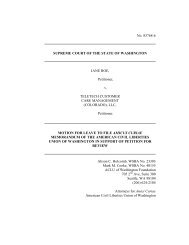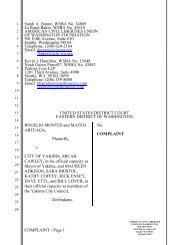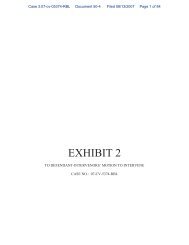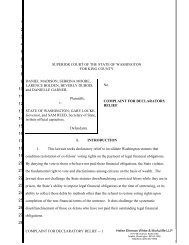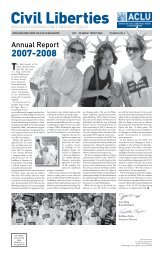BERGER v. CITY OF SEATTLE - ACLU of Washington
BERGER v. CITY OF SEATTLE - ACLU of Washington
BERGER v. CITY OF SEATTLE - ACLU of Washington
You also want an ePaper? Increase the reach of your titles
YUMPU automatically turns print PDFs into web optimized ePapers that Google loves.
<strong>BERGER</strong> v. <strong>CITY</strong> <strong>OF</strong> <strong>SEATTLE</strong><br />
231<br />
is not narrowly tailored because it “targets a particular group<br />
<strong>of</strong> people and not a particular problem such as aggressive begging.”<br />
The district court agreed, holding that Rule F.3.a could<br />
not satisfy the second prong <strong>of</strong> the restriction test: “As with<br />
the permit requirement, . . . the active solicitation ban is not<br />
narrowly tailored. . . . Even more so than with the Rules’ permit<br />
requirement, the mismatch between the solicitation ban’s<br />
aim and its reach is fatal to its constitutionality.”<br />
Our narrow tailoring analysis starts with a view <strong>of</strong> the<br />
city’s interests. The city asserts that Seattle Center authorities<br />
created Rule F.3.a in response to patron complaints regarding<br />
“pushy or overbearing performers,” and tailored the rule to<br />
ensure the convenience <strong>of</strong> patrons and to avoid performances<br />
that might interfere with pedestrian traffic or Seattle Center<br />
exhibitions. Our caselaw confirms that an “interest in protecting<br />
the safety and convenience <strong>of</strong> persons using a public<br />
forum is a valid government objective” and “[g]overnment<br />
interests in promoting public safety and the orderly movement<br />
<strong>of</strong> pedestrians, and in protecting the local merchant economy<br />
are also substantial.” Perry v. L.A. Police Dept., 121 F.3d<br />
1365, 1371 (9th Cir. 1997); cf. Heffron, 452 U.S. at 652 (noting<br />
that the State has a significant interest in “avoiding congestion<br />
and maintaining the orderly movement” <strong>of</strong> patrons at<br />
a public fair).<br />
[15] We have previously upheld bans on certain forms <strong>of</strong><br />
solicitation. 26 In ACORN v. City <strong>of</strong> Phoenix, 798 F.2d 1260<br />
(9th Cir. 1986), we addressed a city ordinance which prohibthe<br />
solicitation rule, which applies to all performers regardless <strong>of</strong> their<br />
message. Berger cites no evidence suggesting content discrimination in the<br />
text or application <strong>of</strong> Rule F.3.a (barring active solicitation by street performers).<br />
26 Rule F.3.a does not completely ban solicitation, for it restricts only<br />
active solicitation, while expressly allowing passive solicitation. Cases<br />
such as Perry v. Los Angeles, 121 F.3d 1365, 1371 (9th Cir. 1997) (invalidating<br />
a total bar on solicitation for certain groups), do not apply.




